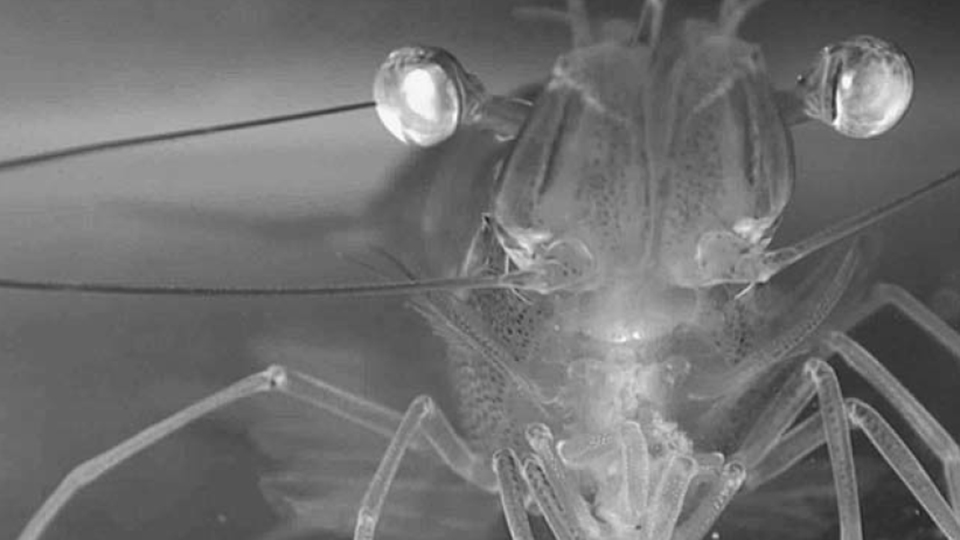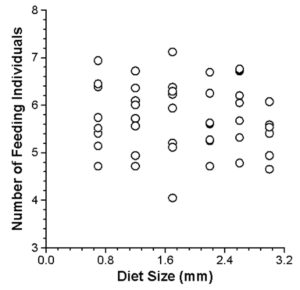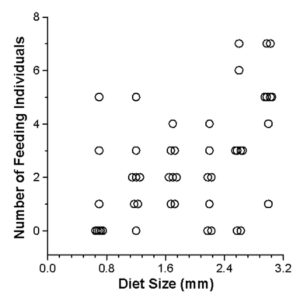Oceanic Institute investigates feed delivery systems, responses to experimental diets

Understanding the behavioral and physical diet preferences of shrimp is important in determining the nutrient and feeding requirements of the animals. The Oceanic Institute (OI) Nutrition Department, with support from a United States Department of Agriculture-Agricultural Research Service grant, investigated the effectiveness of feed delivery systems and shrimp responses to experimental diets. A small component of the project evaluated the effect of diet size on the feeding behavior and growth of shrimp in an indoor culture system.
Experimental methods
Diet preparation and analysis
Six diets were produced by pelleting a 3.0-mm diet and then crumbling to the following sizes: 0.7, 1.2, 1.7, 2.2 and 2.6 mm. These diets were analyzed for proximate composition and water stability following OI standard laboratory procedures.
Growth experiment

The six diets, serving as treatments, were fed to 0.9-gram Pacific white shrimp (Litopenaeus vannamei) for eight weeks in an indoor controlled laboratory. Eight aquariums per treatment were used, with 12 shrimp stocked in each 52-liter rectangular glass aquarium.
A flow-through culture system with a water exchange rate of 100 percent per hour was used to grow the shrimp and maintain desired water quality. Shrimp were weighed at the start and end of the trial, and every two weeks during the trial. All treatments were fed by hand to satiation three times daily and evaluated for final weight, growth, feed-conversion ratio and survival.
Feeding behavior
Feeding behavior was observed three times weekly starting on the fourth week. Carried out immediately after feeding in the morning, noon, and afternoon, the observations focused on two aspects: the number of feeding individuals in each tank and the number of “attacking” incidents. The latter was defined as the behavior of one shrimp to obstruct the feeding behavior of other shrimp.
A total of 45 observations was compiled for each aquarium throughout the trial. The number of feeding individuals and attacks were compared among different diet sizes by analysis of variance followed by Tukey’s test of significance.
Results
As expected, all the diets had similar proximate mean compositions of 4.6 percent moisture, 44.7 percent crude protein, 8.2 percent crude lipid, 14.7 percent ash, and 4371.2 cal per grams energy. Water stability values appeared to show a direct relationship with diet size. The water stability decreased from 80.9 percent to 75.5 percent as the 3.0-mm pellets were reduced to 0.7-mm crumbles.
Effect on feeding behavior

The average number of feeding individuals in each aquarium was not significantly different among the various diet sizes (Fig. 1). However, the total incidents of attacking behavior in each aquarium were significantly different among the diet sizes (Fig. 2).
The attacking behavior of shrimp was observed more frequently in aquariums fed with the larger diet sizes. This suggested that when shrimp were fed larger pellets, some of the individuals may have obstructed other individuals and monopolized the diet. In the long run, such “selfish” behavior of aquacultured animals can result in increased size variation within the final product.
Effect on growth
Table 1 summarizes the shrimp growth performance. Variations in shrimp biological performance were not significantly different among the diet sizes. For sizes ranging 0.7 to 3.0 mm, the final weights ranged 5.34 to 5.92 grams, weekly growth rate ranged 0.55 to 0.63 grams, feed-conversion ratios ranged 1.70 to 2.11, and survival ranged 80.2 to 90.6 percent. This suggested that any of the diet sizes could be used for 1-gram shrimp, although preference could be given to 2.2-mm or 2.6-mm crumbles, due to their higher growth performance.
Obaldo, Biological performance of Pacific white shrimp reared in an indoor culture system, Table 1
| Diet | Weight (g) | Weekly Growth (g) | Feed-Conversion Ratio | Survival (%) |
|---|
Diet | Weight (g) | Weekly Growth (g) | Feed-Conversion Ratio | Survival (%) |
|---|---|---|---|---|
| 0.7-mm crumble | 5.34 ± 0.41 | 0.55 ± 0.05 | 1.84 ± 0.20 | 86.5 ± 7.6 |
| 1.2-mm crumble | 5.50 ± 0.66 | 0.57 ± 0.08 | 1.90 ± 0.28 | 86.5 ± 10.8 |
| 1.7-mm crumble | 5.57 ± 0.64 | 0.58 ± 0.08 | 1.81 ± 0.29 | 88.5 ± 8.8 |
| 2.2-mm crumble | 5.85 ± 0.54 | 0.62 ± 0.07 | 1.70 ± 0.17 | 89.6 ± 10.7 |
| 2.6-mm crumble | 5.92 ± 0.55 | 0.63 ± 0.07 | 1.71 ± 0.08 | 90.6 ± 9.4 |
| 3.0-mm x 3.0-mm pellet | 5.69 ± 0.67 | 0.59 ± 0.08 | 2.11 ± 0.45 | 80.2 ± 10.9 |
Conclusion
Diet size tends to influence the attacking and feeding behavior of shrimp. In this trial, attacking behavior was associated with larger pellets, where some of the individuals monopolized the diet. If shrimp were not fed to satiation, the attacking behavior could have resulted in more serious problems, such as significant size variation and the mortality of smaller individuals. Future studies should consider an experimental period to produce market-size shrimp, to better address diet size and feeding behavior throughout grow-out.
(Editor’s Note: This article was originally published in the June 2003 print edition of the Global Aquaculture Advocate.)
Now that you've finished reading the article ...
… we hope you’ll consider supporting our mission to document the evolution of the global aquaculture industry and share our vast network of contributors’ expansive knowledge every week.
By becoming a Global Seafood Alliance member, you’re ensuring that all of the pre-competitive work we do through member benefits, resources and events can continue. Individual membership costs just $50 a year. GSA individual and corporate members receive complimentary access to a series of GOAL virtual events beginning in April. Join now.
Not a GSA member? Join us.
Authors
-
Leonard G. Obaldo, Ph.D.
The Oceanic Institute
41-202 Kalanianaole Highway
Waimanalo, Hawaii 96795 USA -
Reiji Masuda, Ph.D.
Fisheries Research Station
Kyoto University
Maizuru, Kyoto, Japan
Tagged With
Related Posts

Innovation & Investment
Acoustic control improves feeding productivity at shrimp farms
In systems recently developed for shrimp farms, passive acoustic-based technology enables sensor-based control of multiple automatic feeders. Improved growth and feed conversion have been recorded at commercial farms using the technology.

Health & Welfare
Biofloc trial results in fast shrimp growth, low FCR, high survival
A trial in a lined, greenhouse-enclosed raceway evaluated the use of a heterotrophic biofloc system equipped with aeration, supplemental oxygen injection and centralized heating to achieve good shrimp production.

Aquafeeds
Biosecurity protocols needed for shrimp feeds, feeding practices
Shrimp aquafeeds – live, fresh or formulated – should not be an entry point of potential pathogens to the shrimp and/or to their culture systems.

Health & Welfare
Building a better shrimp nursery, part 3
Shrimp nursery systems offer significant potential for compensatory growth after juveniles are transferred to ponds for final grow-out. Nursery feed selection and their management are critical components of shrimp nursery systems.


